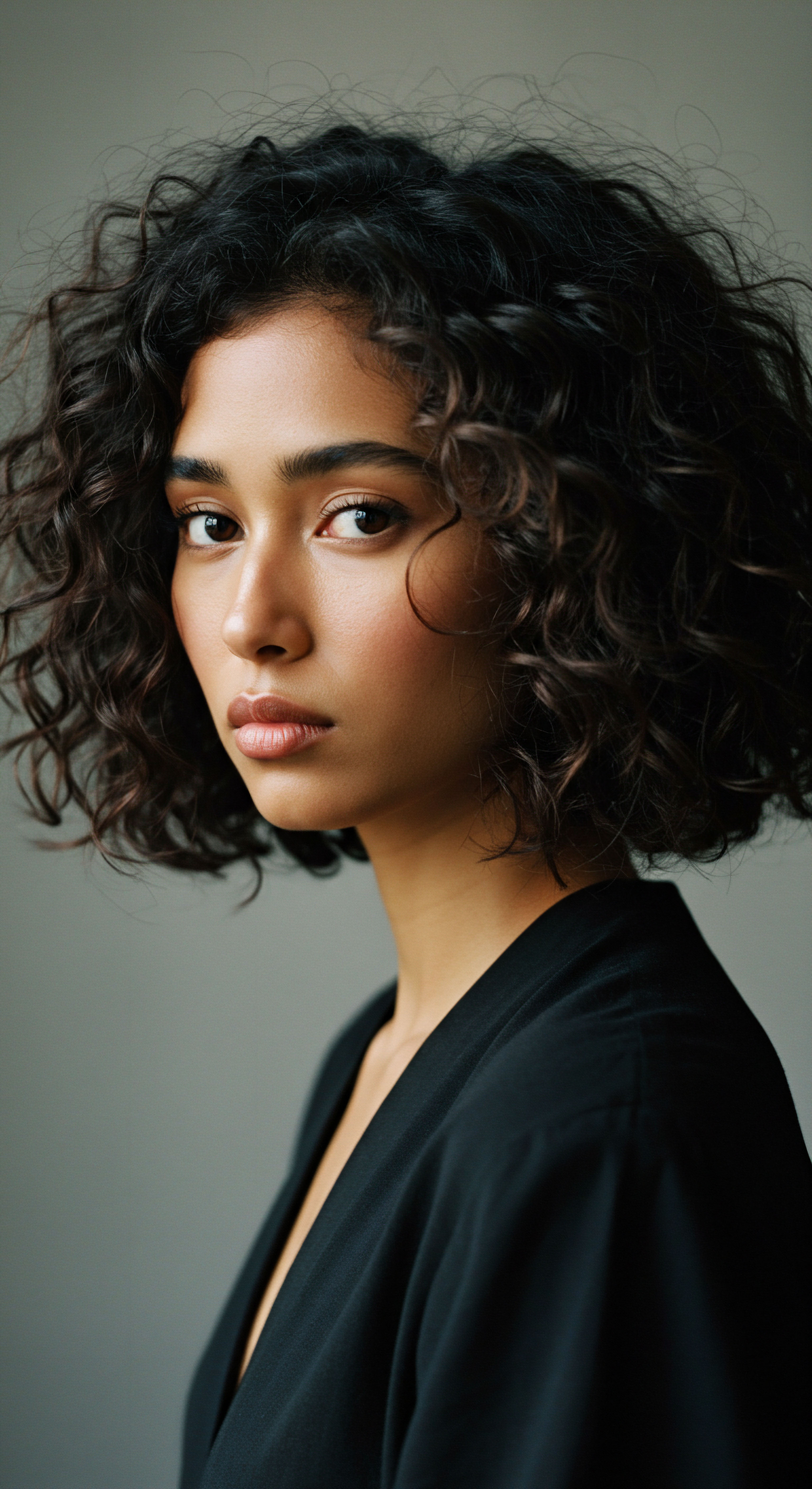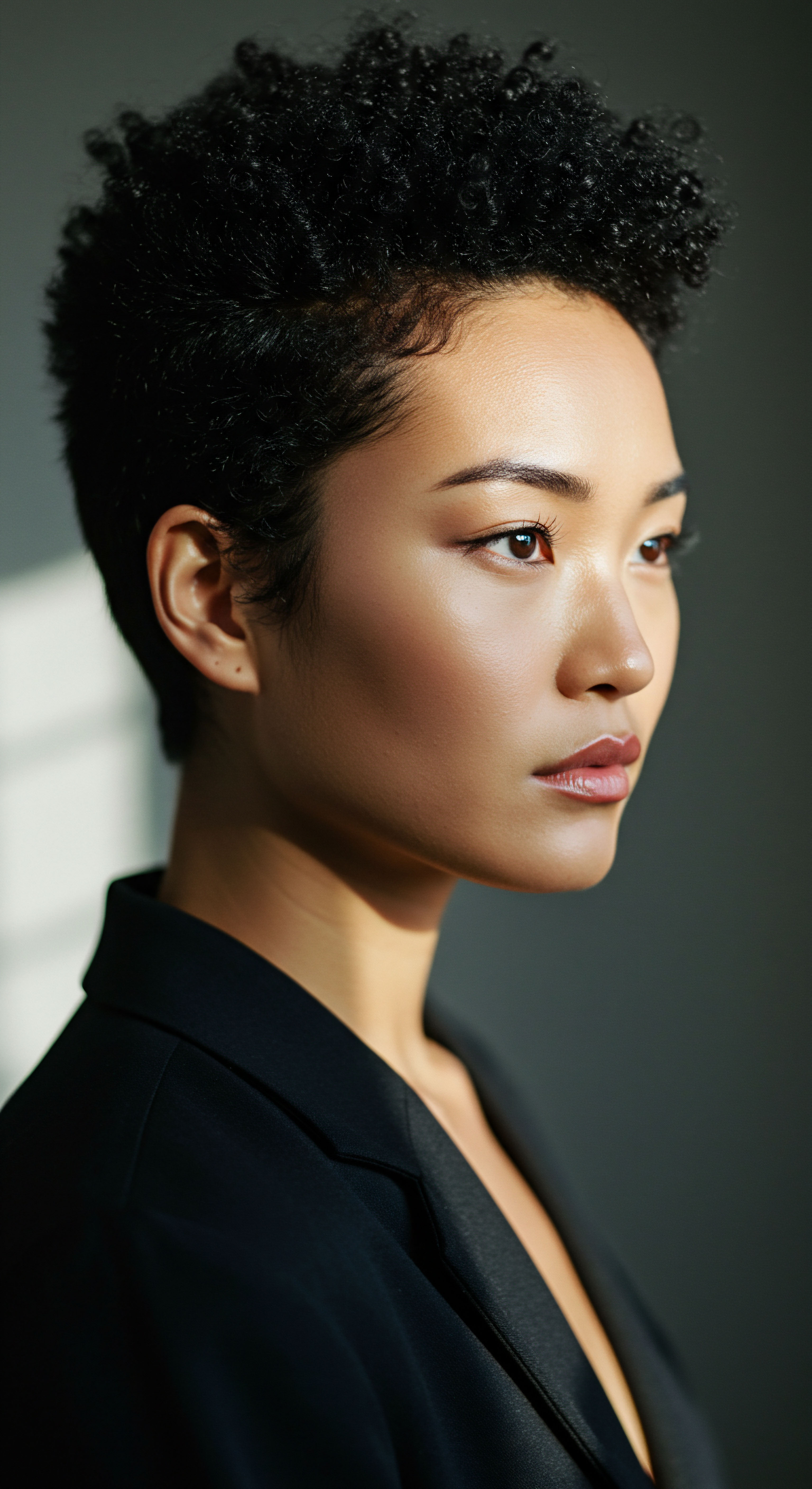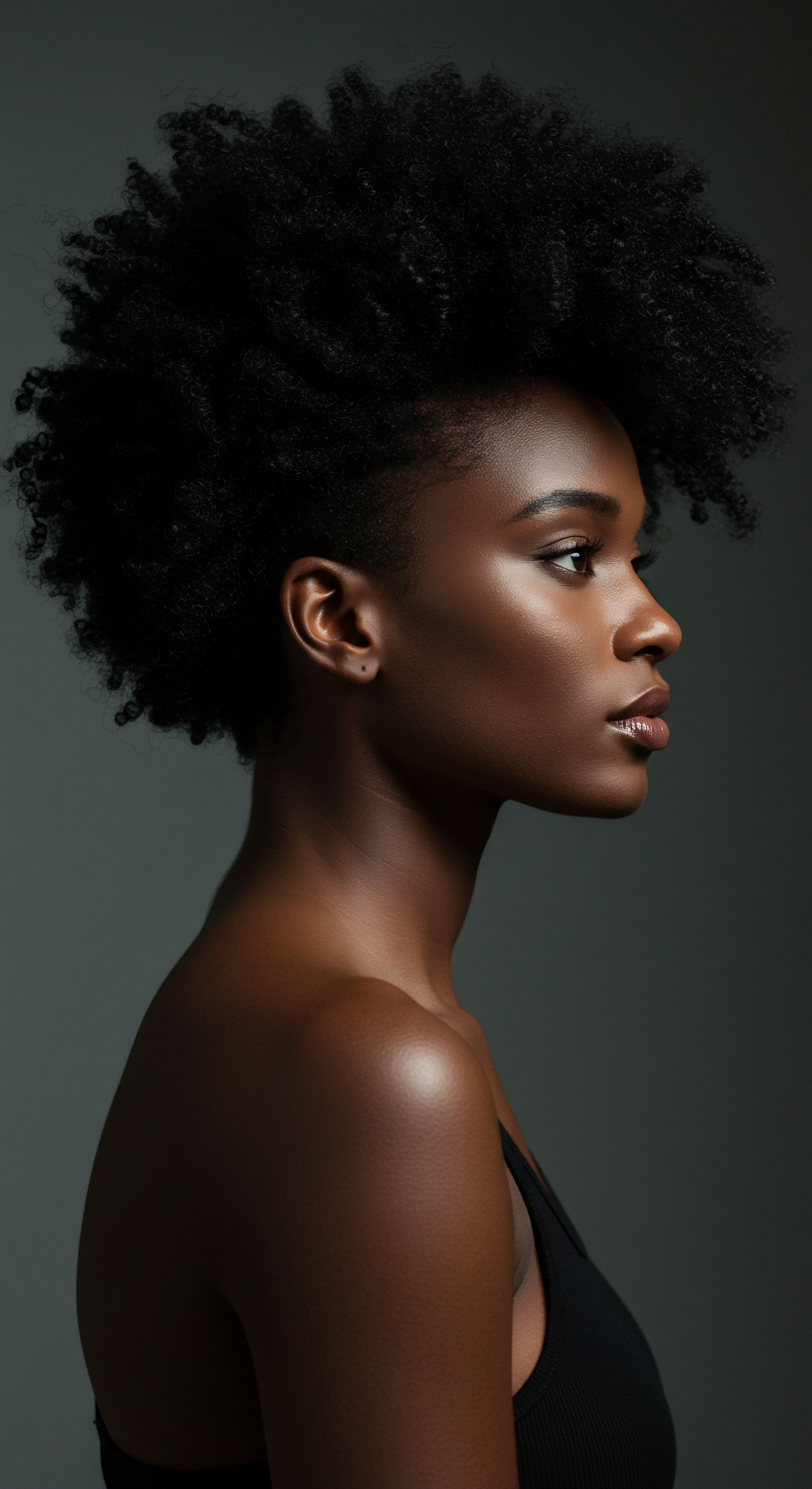
Roots
Consider for a moment the quiet story held within each strand, a whisper of time and connection that reaches back through generations. Hair, a resilient fiber emerging from our very being, has always been more than mere covering. In the dry, sun-drenched expanse of ancient Kemet, the land of the Black Soil, hair spoke volumes, a silent language understood by all. It was a living declaration, a visible chronicle of one’s place within a society meticulously ordered, from the highest echelons to the most humble dwelling.
The ancient Egyptians, with their profound understanding of the natural world and their place within it, saw hair not simply as an organic growth but as a medium for expressing identity, devotion, and rank. Their approach to hair care was not a casual affair; rather, it was a deliberate and often elaborate series of actions that underscored their social hierarchy. The very substances applied, the styles adopted, and the lengths maintained or removed, all contributed to a complex system of non-verbal communication.
Ancient Egyptian hair care was a profound social language, communicating identity and standing through deliberate styling and adornment.

Hair as a Mark of Being
For the ancient Egyptians, hair was intrinsically tied to the individual’s existence, a part of the body that could be styled, shaved, or adorned to convey specific messages. The desert climate, with its intense sun and pervasive sand, also influenced practical considerations for hair maintenance. Keeping hair clean and protected was a constant challenge, leading to the creation of sophisticated unguents and preparations.
The condition of one’s hair could suggest health, a valued attribute in a society deeply connected to cycles of life and regeneration. A well-kept coiffure, gleaming with oils and free from tangles, signaled not only personal attention but also the availability of resources and leisure time required for such meticulous grooming.

Early Interpretations of Hair Status
Even in the earliest dynasties, distinct differences in hair presentation began to surface between various social groups. These distinctions were not always about opulence; sometimes, they involved the complete absence of hair. Priests and priestesses, for instance, often shaved their heads entirely as a sign of purity and dedication to their deities, removing any potential impurities that hair might harbor. This act of removal, while seemingly a denial of adornment, carried its own powerful social and spiritual weight.
- Priestly Shaving ❉ A practice signifying ritual purity and spiritual dedication.
- Royal Adornment ❉ Elaborate wigs and braids indicating power and divine connection.
- Commoner Simplicity ❉ More practical styles, often shorter or simpler braids, reflecting daily life.
The initial steps in understanding ancient Egyptian hair practices involve looking at these foundational choices ❉ whether to keep hair, how to treat it, and what messages these choices conveyed. The fundamental decision to wear one’s natural hair, to shave it, or to wear a wig, already placed an individual within a specific social sphere.

Ritual
When we consider the practices of ancient Egypt, a sense of deliberate action comes to mind, a daily rhythm attuned to purpose. So too was it with hair. Moving beyond the foundational presence of hair, we step into the realm of daily and ceremonial practices, where each comb stroke, each application of balm, was a deliberate act, a ritual shaping not only appearance but also one’s perceived place in the world. The careful selection of tools, the preparation of concoctions, and the time invested in styling all speak to a deeper meaning than simple personal care.
The art of ancient Egyptian hair care was a sophisticated blend of hygiene, aesthetics, and social convention. Archaeological discoveries have brought to light a fascinating array of implements used for grooming, from intricately carved combs made of wood or ivory to sharp razors crafted from bronze or flint. These tools were not merely functional; they were often objects of beauty themselves, reflecting the value placed on the grooming process.
Ancient Egyptian hair practices were elaborate rituals, blending hygiene and aesthetics with precise social conventions.

The Craft of Adornment
The Egyptians employed a wide spectrum of substances to care for their hair. Oils, often derived from plants like castor, moringa, or almond, were applied to moisturize the scalp, condition the strands, and impart a lustrous sheen. These oils also served a protective function, shielding hair from the harsh desert sun and preventing dryness.
Beyond simple oils, more complex formulations were developed. Resins, beeswax, and even animal fats were combined with aromatic plants to create pomades that would hold intricate styles, repel pests, and leave a pleasant scent. The meticulous preparation of these substances speaks to a culture that valued personal presentation as a reflection of order and well-being.

Wigs and Their Significance
Perhaps no aspect of ancient Egyptian hair care better illustrates its social dimensions than the widespread adoption of wigs. These were not simply fashion accessories; they were essential components of elite attire, worn by both men and women. Wigs served multiple purposes ❉ they offered protection from the sun, helped maintain hygiene by allowing natural hair to be kept short or shaved beneath, and most significantly, they were powerful symbols of wealth and social standing.
The creation of wigs was a specialized craft. They were typically made from human hair, often imported, or sometimes from plant fibers. The hair was meticulously attached to a mesh cap using beeswax or resin, then styled into elaborate braids, curls, or layered arrangements. The complexity of the wig, its size, the quality of the hair, and the skill of its construction all contributed to its wearer’s perceived status.
For the affluent, owning multiple wigs for different occasions was common. These could range from simple, short styles for daily wear to voluminous, intricately braided creations reserved for banquets, religious ceremonies, or court appearances. The ability to afford such luxurious items, and the servants required to maintain them, was a clear marker of elevated position.

How Did Wig Styles Vary with Social Standing?
The visual cues provided by wigs were immediate and unmistakable. While commoners might wear simple, functional hairstyles or less elaborate wigs made of coarser materials, the elite adorned themselves with wigs that were works of art. Royal and noble wigs were often long, dense, and styled with precision, sometimes incorporating gold threads, beads, or floral garlands. The famed tripartite wig, often depicted on pharaohs and high-ranking officials, was a particularly iconic symbol of power and authority.
The choice of wig style also reflected gender and age. Men’s wigs often featured shorter, more structured cuts, while women’s wigs could be longer and more flowing, though both genders embraced a wide array of styles. The constant upkeep required for these elaborate wigs—cleaning, re-oiling, and re-styling—necessitated the employment of skilled barbers and wig makers, further solidifying the link between hair care and economic prosperity.
- Wig Material ❉ The quality of hair (human, often imported, versus plant fibers) dictated prestige.
- Wig Complexity ❉ Intricate braiding and multi-layered designs were reserved for the elite.
- Wig Size ❉ Larger, more voluminous wigs often indicated higher status and greater resources.

Relay
As we delve deeper into the layers of ancient Egyptian society, the nuances of hair care extend beyond mere aesthetics or daily ritual. Here, hair transforms into a powerful medium for conveying profound social statements, a visible language of status, belief, and even personal history. The interplay between an individual’s coiffure and their standing within the highly stratified social structure of Kemet reveals a system where every detail, from the sheen of a braid to the absence of a single strand, held significant meaning.
The visible markers of hair care were not accidental; they were carefully cultivated declarations. The very access to certain materials, the time available for elaborate styling, and the knowledge of specific techniques were all privileges of the elite. This differentiation was not always overt; sometimes, it lay in the subtle distinctions of quality, purity, and the sheer effort expended.
Hair in ancient Egypt served as a dynamic visual marker, articulating an individual’s social standing, beliefs, and economic capacity.

Hair as a Symbol of Social Hierarchy
The most apparent division in hair presentation lay between the royalty and nobility, and the common populace. The pharaohs and their inner circle sported the most magnificent wigs and hairstyles, often adorned with precious metals and jewels, signifying their divine connection and immense power. These elaborate displays were not just for show; they reinforced the social order, visually asserting who held authority and who served.
For the average Egyptian, practicality often dictated hair choices. Farmers, laborers, and artisans generally maintained simpler, shorter styles that were easier to manage in the heat and dust of their daily work. While they too practiced hygiene, their resources for elaborate oils, perfumes, or high-quality wigs were limited. Their hair reflected a life of labor, a stark contrast to the leisurely existence suggested by the elite’s immaculate wigs.
Beyond these broad categories, specific social roles carried their own hair conventions. Soldiers, for instance, might have practical, short hair or even shaved heads for ease of helmet wear and to prevent lice. Mourners, conversely, might allow their hair to grow wild and unkempt, or cover it as a sign of grief and temporary withdrawal from social norms.

How Did Ancient Egyptian Hair Care Reveal Social Standing?
The revelations of social standing through hair care in ancient Egypt were multifaceted. One compelling aspect is the chemical analysis of residues found in ancient Egyptian cosmetic containers and on mummified hair . Research has illuminated the sophisticated compositions of hair products used by different social classes. For instance, a study published in the Journal of Archaeological Science analyzing hair samples from various periods and social strata in ancient Egypt found that while simple animal fats and plant oils were accessible to many, the elite had access to more complex formulations.
These formulations often included rare plant extracts, imported resins like frankincense or myrrh, and beeswax in precise ratios, designed not only for conditioning but also for styling and preserving elaborate coiffures. This suggests a distinction not just in the presence of hair care, but in the luxury and scientific understanding behind it. The mere presence of certain rare aromatic compounds in the hair of a noble, as opposed to a commoner, served as a direct chemical marker of their economic capacity and access to specialized resources.
Furthermore, the state of preservation of mummified hair itself can provide clues. While many mummies show signs of excellent hair preservation due to the embalming process, detailed examinations have sometimes revealed the extent of prior damage or the effectiveness of protective treatments. Hair from individuals of lower social standing, often buried with less elaborate mummification, might show more signs of environmental stress or less meticulous prior care. Conversely, the hair of the elite, preserved with rich oils and resins, often maintained its integrity and even some elasticity, a testament to the resources poured into their personal care, even in death.
Consider the barbers and wig makers, who were themselves a specialized class. The most skilled among them would have served the royal court and the highest nobility, commanding significant respect and remuneration. Their expertise was essential to maintaining the elaborate hair standards of the elite. The sheer cost of their services, combined with the expense of the raw materials (like imported human hair for wigs), meant that only the wealthiest could sustain such meticulous appearances.
| Element Wig Quality |
| Elite Social Standing Finely woven human hair, intricate styles, large volume. |
| Common Social Standing Coarser plant fibers, simpler designs, smaller size. |
| Element Hair Products |
| Elite Social Standing Complex balms, rare oils, imported resins, perfumed. |
| Common Social Standing Simple animal fats, basic plant oils, unperfumed. |
| Element Hair Length/Style |
| Elite Social Standing Elaborate, long, braided, curled, often wig-based. |
| Common Social Standing Short, practical, natural, simpler braids. |
| Element Grooming Tools |
| Elite Social Standing Ornate combs, bronze razors, polished mirrors. |
| Common Social Standing Basic wooden combs, flint razors, less refined. |
| Element Professional Care |
| Elite Social Standing Regular services from skilled barbers/wig makers. |
| Common Social Standing Self-care or assistance from family members. |
| Element The divergence in hair care resources and practices clearly demarcated social strata. |

Hair and the Afterlife
The significance of hair extended even into the afterlife. Mummified remains often show careful attention to hair, with wigs placed on the deceased or natural hair meticulously styled and treated with resins. This practice underscored the belief that the physical body, including its hair, was essential for existence in the realm beyond.
Preserving and presenting hair beautifully in death mirrored its importance in life, ensuring the deceased carried their earthly status and identity into eternity. The elaborate funerary wigs and hair treatments found in elite tombs stand as enduring monuments to this profound connection between hair, status, and the cosmic order.
This cultural understanding of hair as a profound indicator offers a lens through which to consider how appearance, resources, and societal structure intertwine. The practices of ancient Egypt remind us that personal presentation is rarely a superficial concern; often, it is a deep expression of identity and belonging within a collective.

Reflection
The silent language of hair, stretching across millennia, continues to whisper its tales. From the sun-drenched banks of the Nile, we gather insights into a world where each strand, each coiffure, was a deliberate brushstroke on the canvas of social standing. It reminds us that our outward presentations, even today, carry echoes of these ancient practices, shaping perceptions and reinforcing roles. What unspoken declarations do our own strands make in the modern world?

References
- Fletcher, Joann. “Ancient Egyptian Hair and Wigs.” In A History of Hair ❉ Fashion and Fantasy. Victoria and Albert Museum, 2000.
- Lucas, Alfred. Ancient Egyptian Materials and Industries. Dover Publications, 1999.
- Stevens, J. et al. “Analysis of hair from Egyptian mummies ❉ Evidence for hair treatment.” Journal of Archaeological Science, vol. 34, no. 10, 2007, pp. 1656-1662.
- Robins, Gay. The Art of Ancient Egypt. Harvard University Press, 2008.
- Shaw, Ian, and Nicholson, Paul. The British Museum Dictionary of Ancient Egypt. The British Museum Press, 2008.
- Tyldesley, Joyce. Egypt ❉ From the Pharaohs to the Fall of Rome. Routledge, 2011.
- Manniche, Lise. An Ancient Egyptian Herbal. University of Texas Press, 2006.
- Brewer, Douglas J. and Teeter, Emily. Egypt and the Egyptians. Cambridge University Press, 2007.